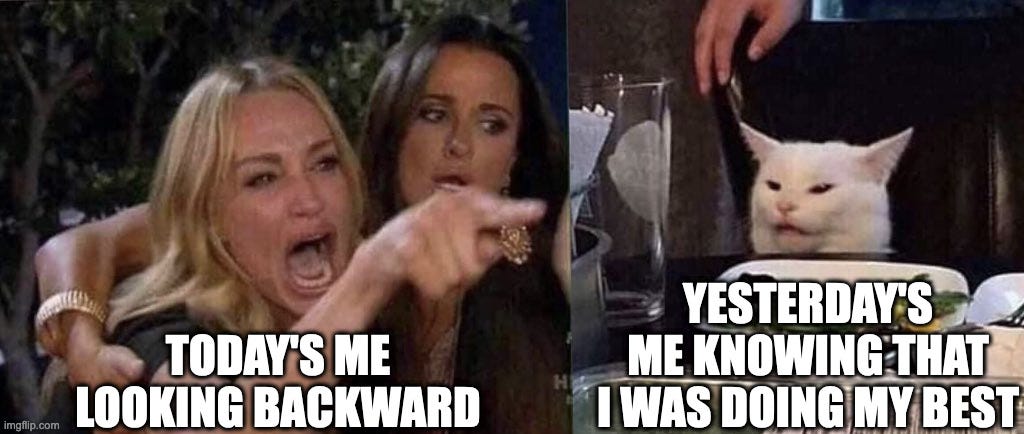Retrospective after one year at Creditas
Last Friday was the last day at Creditas.
Retrospectives are one of the best ways that I know today for Continuous Improvement. So, here it comes a retrospective of this year at Creditas and what I learned.
Went well 😊
Met and worked with amazing people 🙌
Learned Brasilian Portuguese 🇧🇷
Learned about Kanban Maturity Model
Able to perform various Workshops and internal training on:
Domain-Driven Design
Event Storming
4 Key Metrics of Accelerate
Distributed Systems Fundamentals
Gained more experience in Engineering Strategy
Gained more experience in running Remote Distributed Teams
Pull Systems instead of Push Systems to drive change
Improved my visual collaboration and communication skills
Gained experience in big company organization methods
Quarter Planning
Job Design Definition
Moved from a Feature Team to a Product Team mindset
Aligned expectations with high-level leadership and business
Helped the team to gain the necessary skills and ceremonies to do so
Facilitated several Lean Inceptions to build a Product Vision and a Quater Roadmap
Tribe Level Domain Discoveries and Team Allocations with
Event Stormings
Bounded Contexts
Context Mappings
Prioritization beats efficiency
Able to switch from a delayed product to delight our customers impacting their journey by dropping heavily the scope and narrowing the efforts towards the big pains and gains.
When the situation is dramatic, make big educated decisions.
Applied Cynefin Framework
Learned to drop a lot of stuff, and I mean I dropped a lot of stuff. Being unable to attend to everything and able to work with ambiguity and uncertainty has been a huge challenge.
People make the decision to step into a leadership career when they are exposed to meaningful leadership 🧡
I had the opportunity to learn how showing the path helped people to want to start their leadership career in an organization that it’s hard due to the need for synchronicity (a lot of meetings)
Great people in the People department make the difference 👏
Thank you Laura to show me the impact of a Business Partner 🧡
Good experimentation and learning culture drive everything else.
Give the team the space to experiment and try stuff
When the team looks for guidance, providing a safety net for experimentation and challenging them worked better.
Not so well 😰
Legacy Sociotechnical Systems influenced more of my decisions than I was aware of.
If a company is relying on synchronous communication and collaboration, moving to more asynchronous won’t happen without proper effort.
Synchronous collaboration lets into less efficiency due to all teams relying more and more on sync to get the job done
This is also reflected in the architectural patterns used.
Overuse of Partnership and Mutually Dependent or Downstream/Upstream collaboration patterns of Context Mapping
When tough situations happen, people go back to the old ways of working as a safe zone.
If we look at Kanban Maturity Model, it’s like moving to one less level of maturity, but it usually doesn’t go back to 2 levels.
Hiring is hard.
Hiring leaders is harder
Firing is also hard.
Rebuilding team trust after a firing happened is harder
Leadership rotation can let to dysfunction when not properly managed
Then, a huge effort is being done to correct that dysfunction.
Given enough Big Lead Time, you start becoming Waterfall aiming to decrease the uncertainty and be more predictable.
This doesn’t work.
When the Debt is too much, a radical effort needs to be done to decrease it to stay competitive. This radical effort is still more than I expected in the first place.
Manageable Debt can be considered strategically important to protect yourself from competitors. Where competitors can be:
Other companies
Cybersecurity threats
Manageable Debt can be seen from several perspectives. You might have a manageable debt to deliver features but not for adapting architecture fast. Having a good Lead Time in delivering features doesn’t mean you finished removing strategic technical debt.
A team that’s gaining confidence on how to work together, needs time for those habits to become working pillars. Give the proper space for the team until they settle the practices and methodologies.
New ideas 🤔
Understand Money Flow earlier 💸
Dedicate more effort to Expectations Alignment and Employee Experience.
It’s worth every minute 🧡
Leadership Training to set the Fundamentals of Ways of Working
In order to improve async communication and collaboration, today I would:
Make it part of the Job Expectations
Make a top-down commitment to how we want to improve our async
Provide training on async




I'm really enjoying reading your posts, Aleix .. really great, clever and useful stuff. Specially the design and engineering strategy posts ... this is really the kind of subject that is hardly shared, which cause a false impression that nobody is doing this or is not that important.
Anyway ...
Boa sorte na sua próxima jornada.